An Analytical Feasibility Study for Solar Panel Installation in Qatar Based on Generated to Consumed Electrical Energy Indicator
Abstract
1. Introduction
2. Solar Energy Projects in Qatar
3. Analytical Solution
4. Calculations of Scenarios
4.1. LPE vs. LPN (20% vs. 2 Panels)
4.2. LPE vs. MPN (20% vs. 4 Panels)
4.3. LPE vs. HPN (20% vs. 6 Panels)
4.4. MPE vs. LPN (40% vs. 2 Panels)
4.5. MPE vs. MPN (40% vs. 4 Panels)
4.6. MPE vs. HPN (40% vs. 6 Panels)
4.7. HPE vs. LPN (50% vs. 2 Panels)
4.8. HPE vs. MPN (50% vs. 4 Panels)
4.9. HPE vs. HPN (50% vs. 6 Panels)
5. GtoC Use Cases
5.1. Comparing Different Installation Scenarios
5.2. New RE Energy Rating Index
5.3. GtoC as Investment Index
5.4. Maintenance, Upgrade Planning, and Decision-Making Index
6. Conclusions
Author Contributions
Funding
Data Availability Statement
Conflicts of Interest
References
- Zainaa, S.; Sadaf, S.; Kunjuc, A.; Meraj, M.; Unal, D.; Touati, F. Statistical Assessment of Renewable Energy Generation in Optimizing Qatar Green Buildings. arXiv 2021, arXiv:2103.07881. Available online: https://www.researchgate.net/publication/350087529_Statistical_Assessment_of_Renewable_Energy_Generation_in_Optimizing_Qatar_Green_Buildings (accessed on 27 June 2022).
- World Data. Sunrise and Sunset in Qatar. Available online: https://www.worlddata.info/asia/qatar/sunset.php (accessed on 27 June 2022).
- Bachour, D.; Perez–Astudillo, D. Ground-measurement GHI map for Qatar. Energy Procedia 2014, 49, 2297–2302. [Google Scholar] [CrossRef][Green Version]
- Meltzer, J.; Hultman, N.E.; Langley, C. Low-Carbon Energy Transitions in Qatar and the Gulf Cooperation Council Region; Global Economy and Development at Brookings: New York, NY, USA, 2014; Available online: https://www.brookings.edu/wp-content/uploads/2016/07/low-carbon-energy-transitions-qatar-meltzer-hultman-full.pdf (accessed on 27 June 2022).
- Alnaser, W.E.; Alnaser, N.W. The impact of the rise of using solar energy in GCC countries. In Renewable Energy and Sustainable Buildings (Innovative Renewable Energy); Sayigh, A., Ed.; Springer: Cham, Switzerland, 2020; pp. 167–183. [Google Scholar] [CrossRef]
- Kamal, W.A. A solar pond for air conditioning a small family house in Qatar. Eng. J. Qatar Univ. 1992, 5, 163–176. [Google Scholar]
- Guo, B.; Javed, W.; Figgis, B.W.; Mirza, T. Effect of dust and weather conditions on photovoltaic performance in Doha, Qatar. In Proceedings of the 2015 First Workshop on Smart Grid and Renewable Energy (SGRE), Doha, Qatar, 22–23 March 2015; pp. 1–6. [Google Scholar] [CrossRef]
- Aksakal, A.; Rehman, S. Global solar radiation in north-eastern Saudi Arabia. Renew. Energy 1999, 17, 461–472. [Google Scholar] [CrossRef]
- Anadolu Agency. Japan to Provide $330 M for Qatar Mega Solar Power Plant. Available online: https://www.aa.com.tr/en/middle-east/japan-to-provide-330m-for-qatar-mega-solar-power-plant/1940284 (accessed on 27 June 2022).
- Total Energies. Total to Develop Qatar’s First Large-Scale (800 MWp) Solar Plant. Available online: https://totalenergies.com/media/news/press-releases/total-develop-qatars-first-large-scale-800-mwp-solar-plant#:~:text=Qatar (accessed on 27 June 2022).
- Total Energies. Al Kharsaah, a Pioneering Solar Power Plant in Qatar. Available online: https://totalenergies.com/projects/renewables-electricity/al-kharsaah-pioneering-solar-power-plant-qatar (accessed on 27 June 2022).
- Elrahmani, A.; Hannun, J.; Eljack, F.; Kazi, M.K. Status of renewable energy in the GCC region and future opportunities. Curr. Opin. Chem. Eng. 2021, 31, 100664. [Google Scholar] [CrossRef]
- Bakhtiarian, M.F. Investment Guide in Qatar. In Proceedings of the 4th International Conference on Business, Management & Economics, Berlin, Germany, 15–17 December 2020. [Google Scholar]
- Tan, T.; Al–Khalaqi, A.; Al–Khulaifi, N. Qatar National Vision 2030. Sustain. Dev. Apprais. Gulf Reg. 2014, 19, 65–81. [Google Scholar]
- Scharfenort, N. Urban development and social change in Qatar: The Qatar National Vision 2030 and the 2022 FIFA World Cup. J. Arab. Stud. 2012, 2, 209–230. [Google Scholar] [CrossRef]
- Okonkwo, E.C.; Wole–Osho, I.; Bamisile, O.; Abid, M.; Al–Ansari, T. Grid integration of renewable energy in Qatar: Potentials and limitations. Energy 2021, 235, 121310. [Google Scholar] [CrossRef]
- Goundar, S. Research Methodology and Research Method; Victoria University of Wellington: Wellington, New Zealand, 2012. [Google Scholar]
- Alrawi, O.; Bayram, I.S.; Al-Ghamdi, S.G.; Koc, M. High-resolution household load profiling and evaluation of rooftop pv systems in selected houses in qatar. Energies 2019, 12, 3876. [Google Scholar] [CrossRef]
- YES Energy Solutions. How Much Energy do Solar Panels Produce for Your Home? Available online: https://www.yesenergysolutions.co.uk/advice/how-much-energy-solar-panels-produce-home (accessed on 27 June 2022).
- Fouad, M.M.; Shihata, L.A.; Morgan, E.I. An integrated review of factors influencing the performance of photovoltaic panels. Renew. Sustain. Energy Rev. 2017, 80, 1499–1511. [Google Scholar] [CrossRef]
- Vidyanandan, K.V. An overview of factors affecting the performance of solar PV systems. Energy Scan 2017, 27, 216. [Google Scholar]
- Osma–Pinto, G.; Ordóñez–Plata, G. Measuring factors influencing performance of rooftop PV panels in warm tropical climates. Sol. Energy 2019, 185, 112–123. [Google Scholar] [CrossRef]
- Bakar, N.N.A.; Hassan, M.Y.; Abdullah, H.; Rahman, H.A.; Abdullah, M.P.; Hussin, F.; Bandi, M. Energy efficiency index as an indicator for measuring building energy performance: A review. Renew. Sustain. Energy Rev. 2015, 44, 1–11. [Google Scholar] [CrossRef]
- Hoen, B.; Wiser, R.H.; Cappers, P.; Thayer, M.A. An Analysis of the Effects of Residential Photovoltaic Energy Systems on Home Sales Prices in California. Ernest Orlando Lawrence Berkeley National Laboratory 2011, LBNL-4476E. Available online: https://eta-publications.lbl.gov/sites/default/files/lbnl-4476e.pdf (accessed on 27 June 2022).
- Marti, L.; Puertas, R. Sustainable energy development analysis: Energy Trilemma. Sustain. Technol. Entrep. 2022, 1, 100007. [Google Scholar] [CrossRef]
- PV Magazine International. KPIs Solar Operators should be Tracking to Overcome the Data Deluge. Available online: https://www.pv-magazine.com/2021/09/27/kpis-solar-operators-should-be-tracking-to-overcome-the-data-deluge/ (accessed on 27 June 2022).
- Limentani, G.B.; Ringo, M.C.; Ye, F.; Berquist, M.L.; McSorley, E.O. Beyond the t-test: Statistical equivalence testing. Anal. Chem. 2005, 77, 221A–226A. [Google Scholar] [CrossRef]
- Siddikov, I.; Khujamatov, K.; Khasanov, D.; Reypnazarov, E. IoT and intelligent wireless sensor network for remote monitoring systems of solar power stations. In Proceedings of the 11th World Conference “Intelligent System for Industrial Automation” (WCIS-2020) (Advances in Intelligent Systems and Computing, 1323); Aliev; Aliev, R.A., Yusupbekov, N.R., Kacprzyk, J., Pedrycz, W., Sadikoglu, F.M., Eds.; Springer: Cham, Switzerland, 2020; pp. 186–195. [Google Scholar] [CrossRef]
- Pandey, A.K.; Tyagi, V.V.; Jeyraj, A.; Selvaraj, L.; Rahim, N.A.; Tyagi, S.K. Recent advances in solar photovoltaic systems for emerging trends and advanced applications. Renew. Sustain. Energy Rev. 2016, 53, 859–884. [Google Scholar] [CrossRef]
- Alrawi, O.; Bayram, I.S.; Koc, M.; Al-Ghamdi, S.G. Economic Viability of Rooftop Photovoltaic Systems and Energy Storage Systems in Qatar. Energies 2022, 15, 3040. [Google Scholar] [CrossRef]
- Bauner, C.; Crago, C.L. Adoption of residential solar power under uncertainty: Implications for renewable energy incentives. Energy Policy 2015, 86, 27–35. [Google Scholar] [CrossRef]
- Darwish, S.; Abdo, H.; AlShuwaiee, W.M. Opportunities, challenges and risks of transition into renewable energy: The case of the Arab Gulf Cooperation Council. Int. Energy J. 2018, 18, 391–400. [Google Scholar]
- Chakraborty, S.; Li, J.; Bhattacharya, P. The solution to the global energy crisis with new materials, and sustainability. J. Phase Change Mater. 2021, 1. [Google Scholar] [CrossRef]
- Provost, F.; Fawcett, T. Data science and its relationship to big data and data–driven decision making. Big Data 2013, 1, 51–59. [Google Scholar] [CrossRef] [PubMed]
- Hafeznia, H.; Aslani, A.; Anwar, S.; Yousefjamali, M. Analysis of the effectiveness of national renewable energy policies: A case of photovoltaic policies. Renew. Sustain. Energy Rev. 2017, 79, 669–680. [Google Scholar] [CrossRef]
- Javed, W.; Wubulikasimu, Y.; Figgis, B.; Guo, B. Characterization of dust accumulated on photovoltaic panels in Doha, Qatar. Sol. Energy 2017, 142, 123–135. [Google Scholar] [CrossRef]
- Bartlett, K.S. Dust Storm Forecasting for Al Udeid AB, Qatar: An Empirical Analysis. Master’s Thesis, United States Air Force, Washington, DC, USA, March 2004. [Google Scholar]
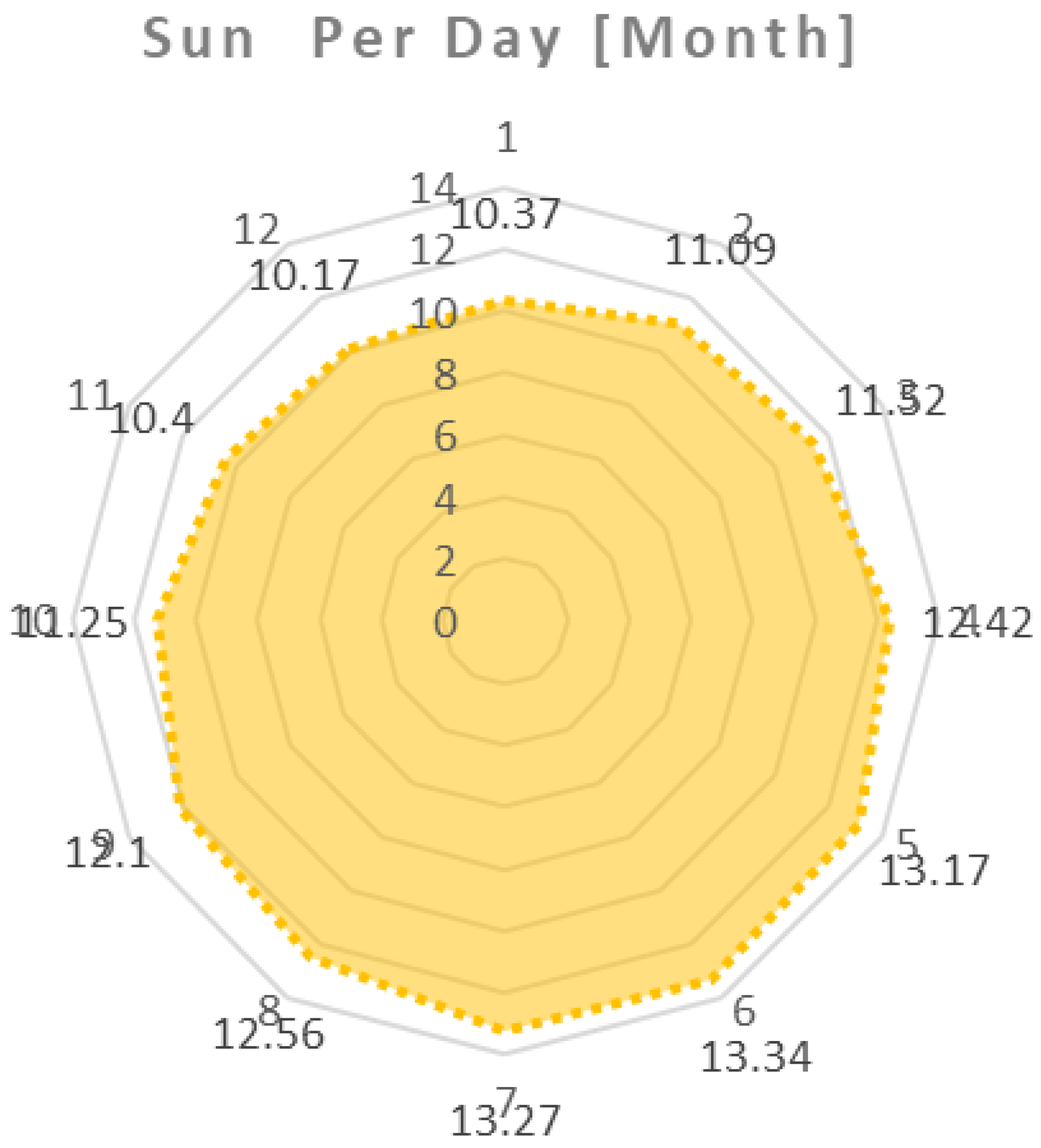
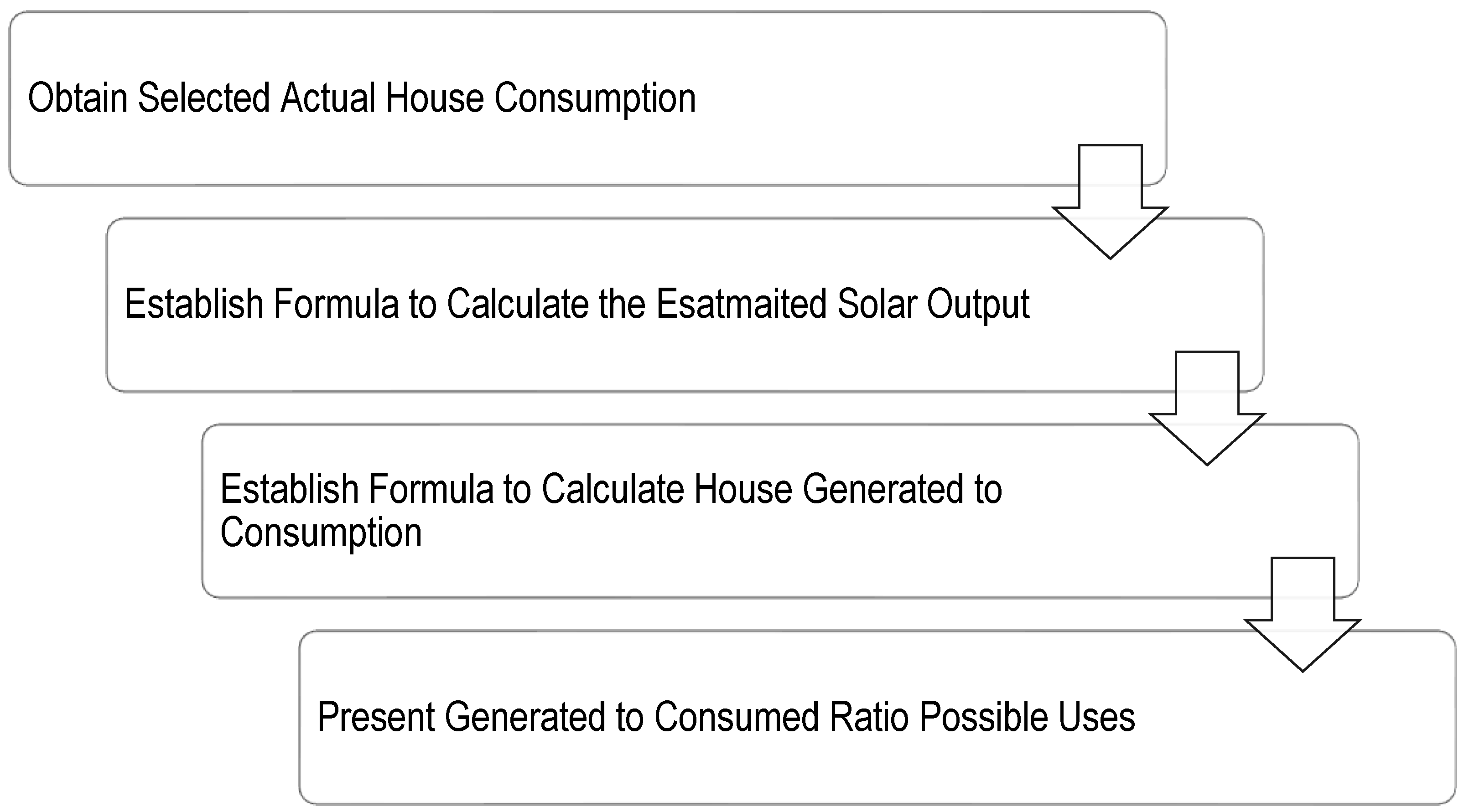
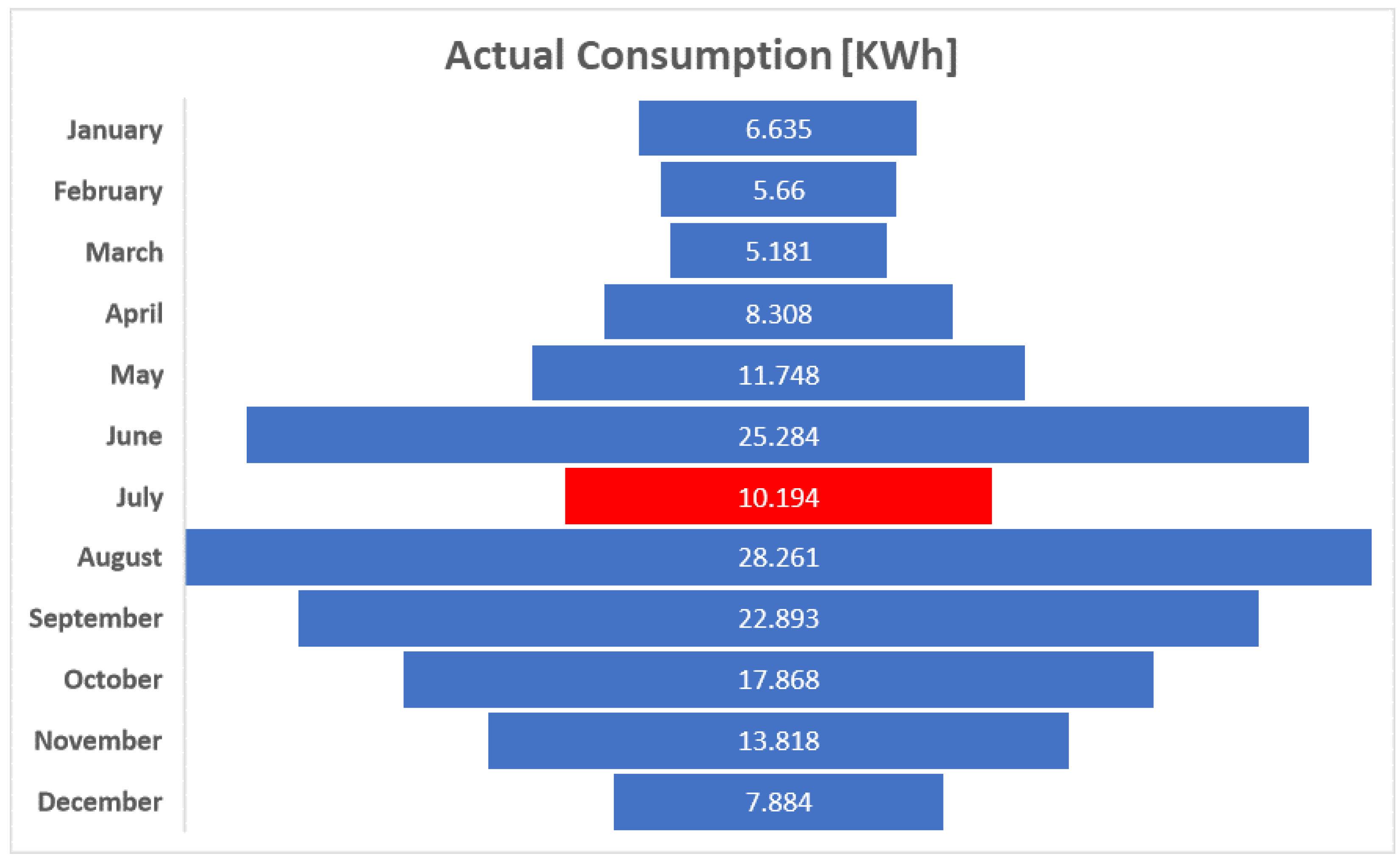
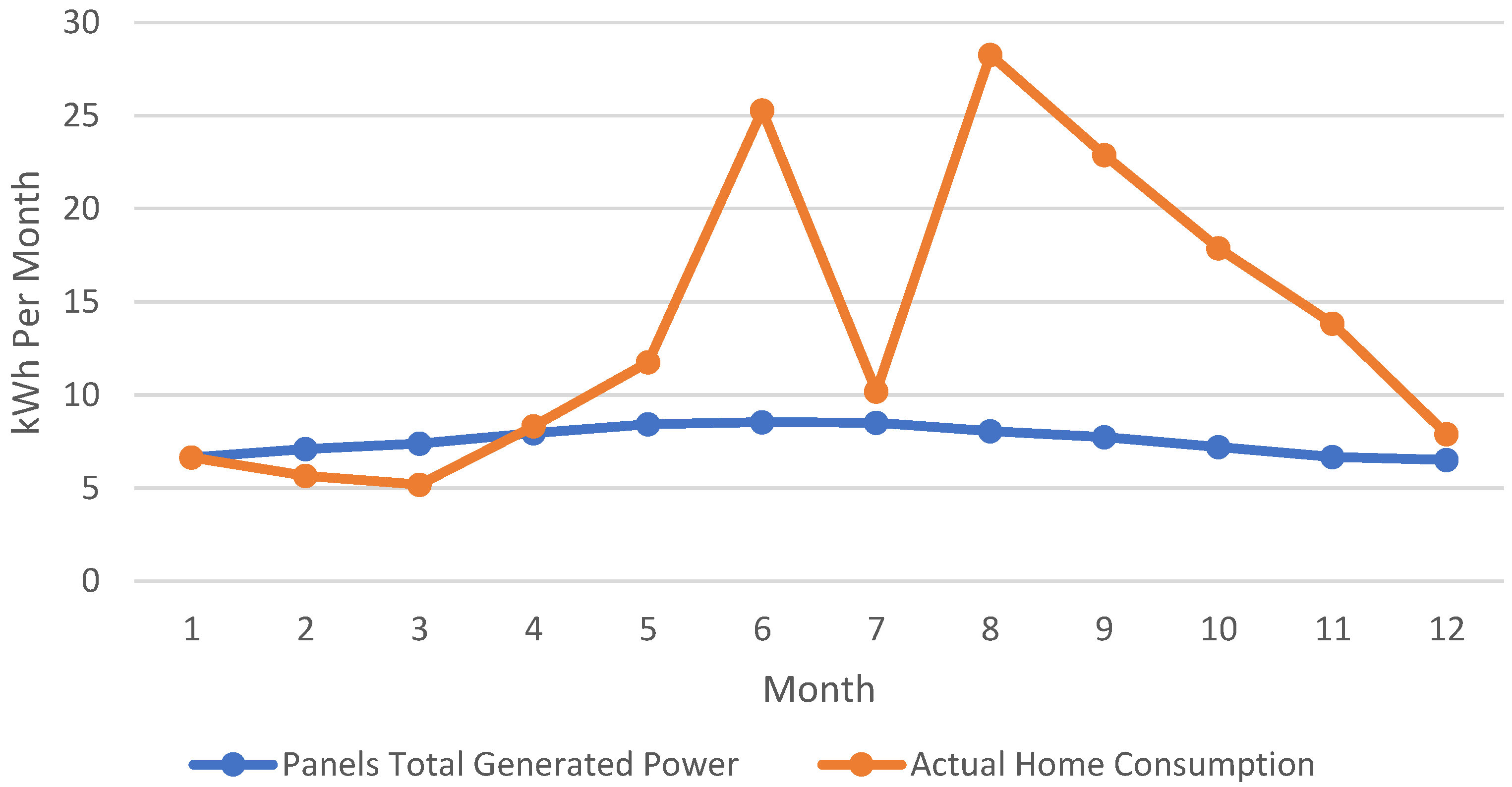
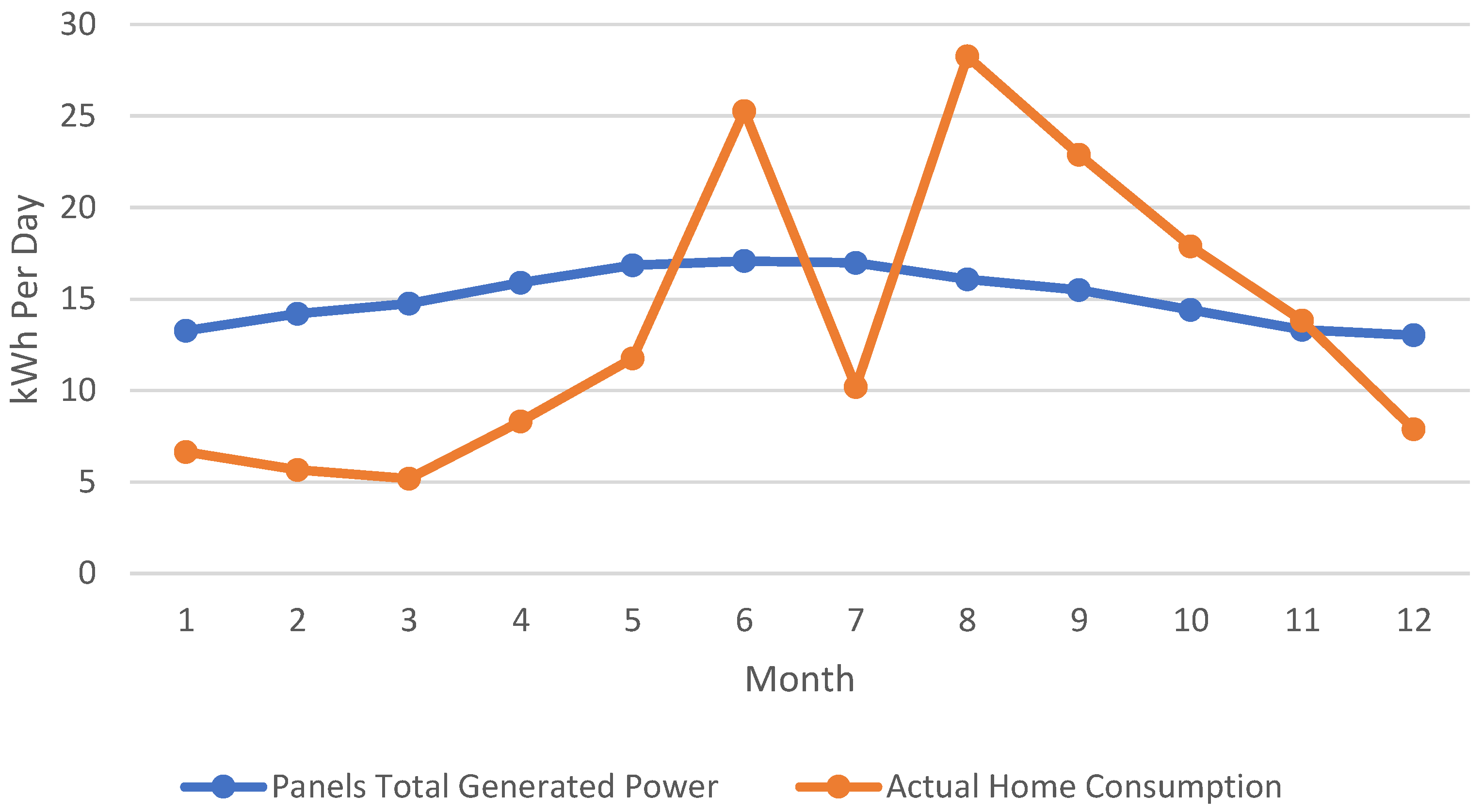
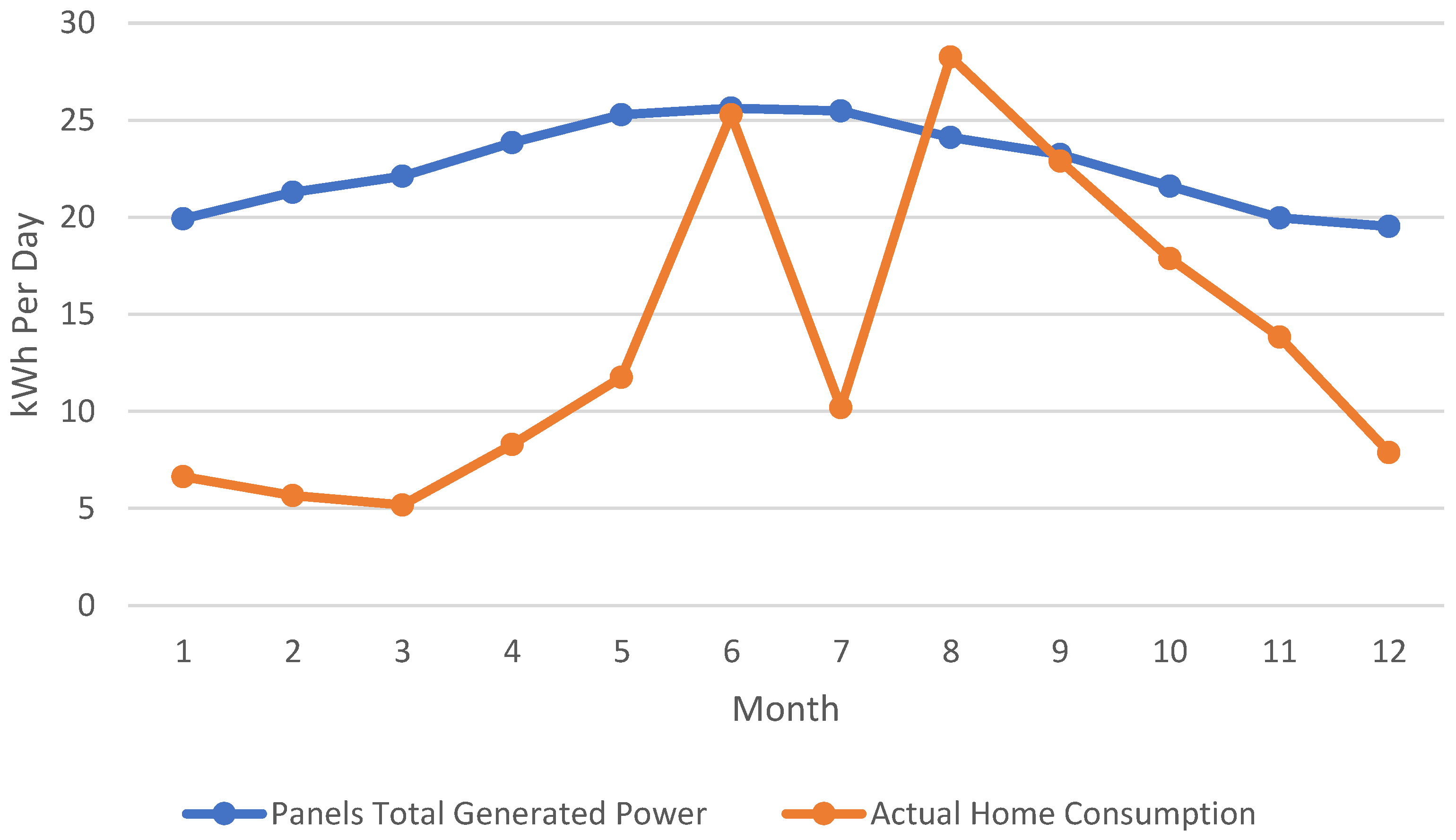
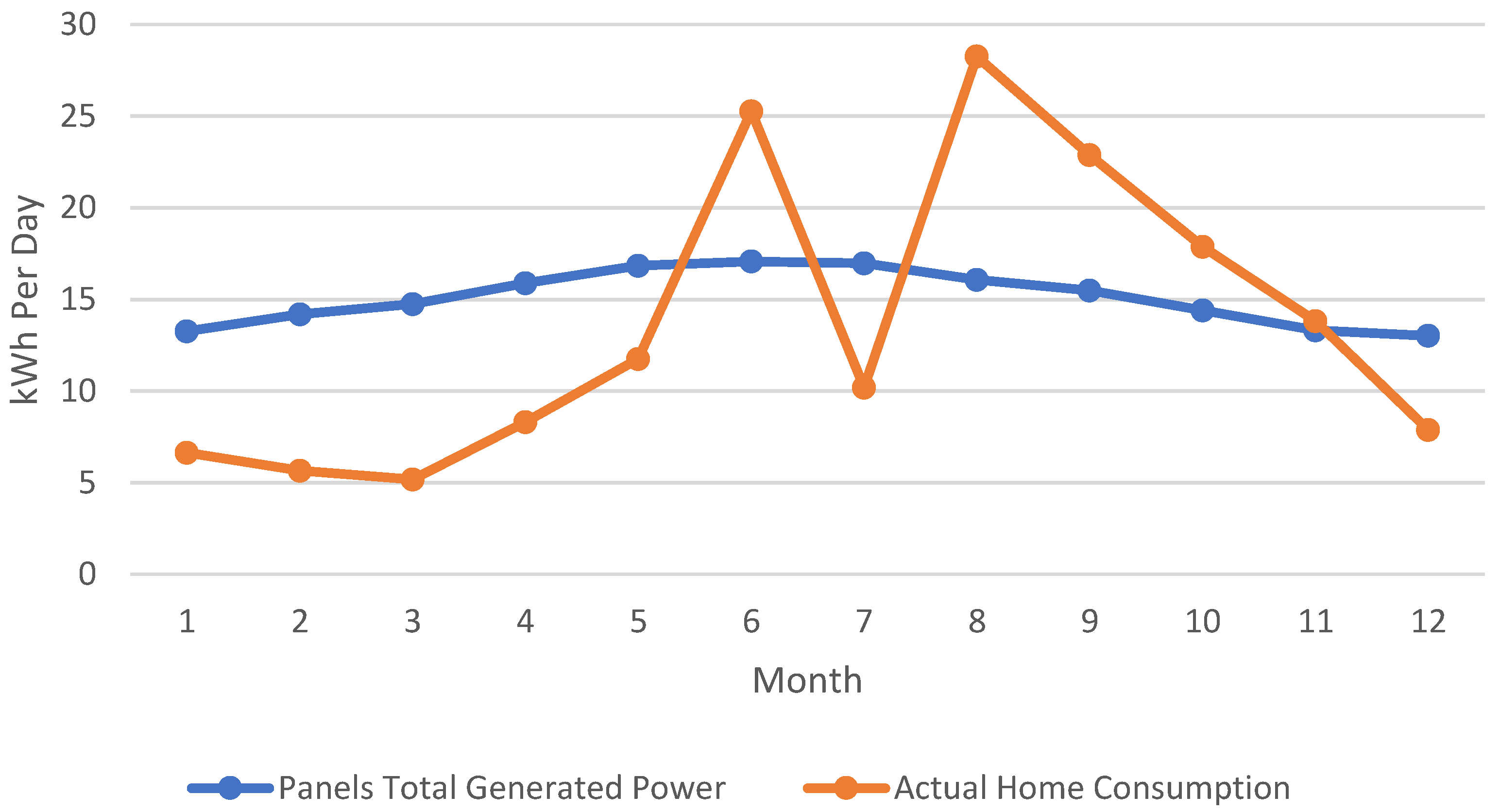
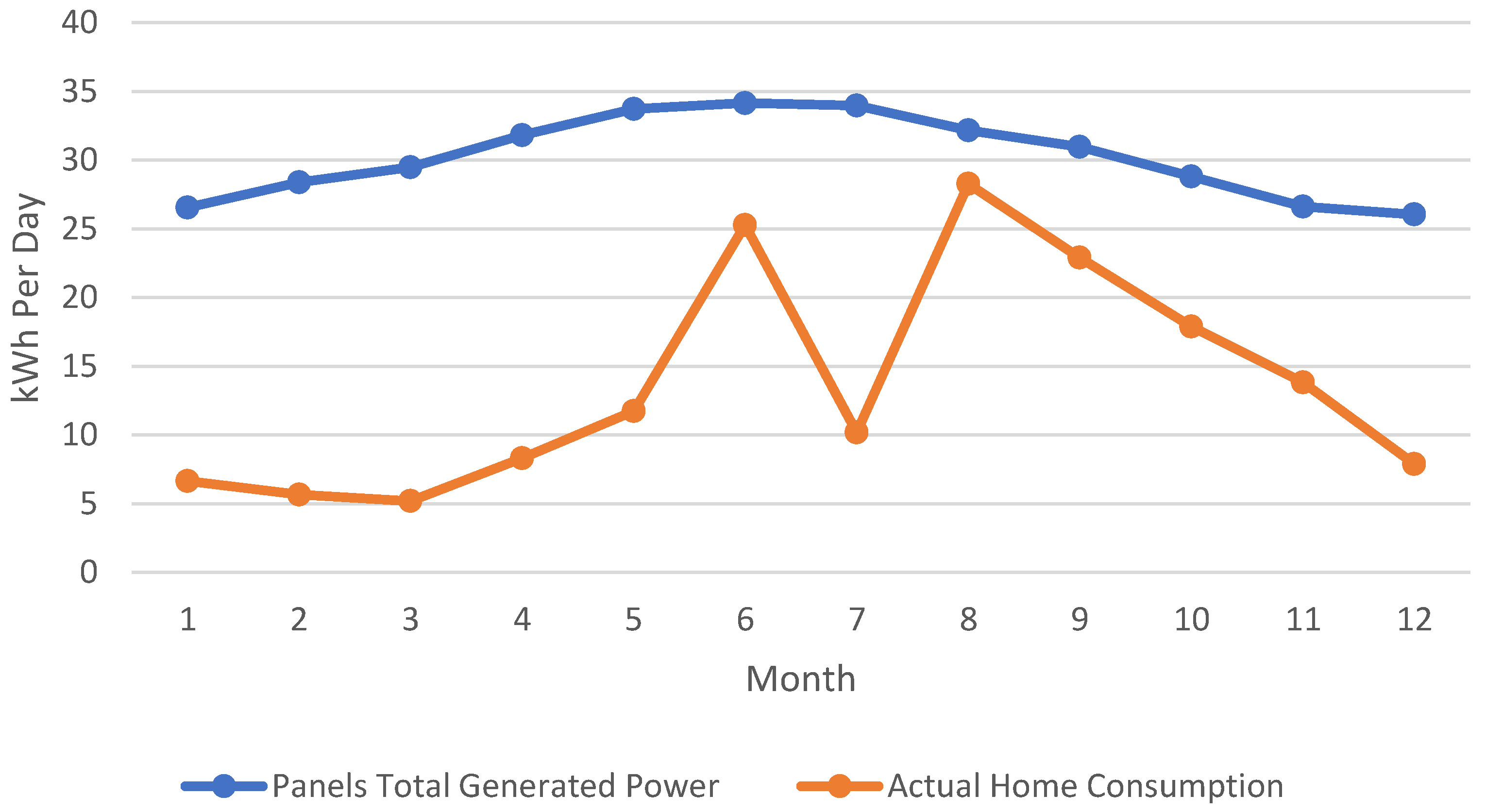
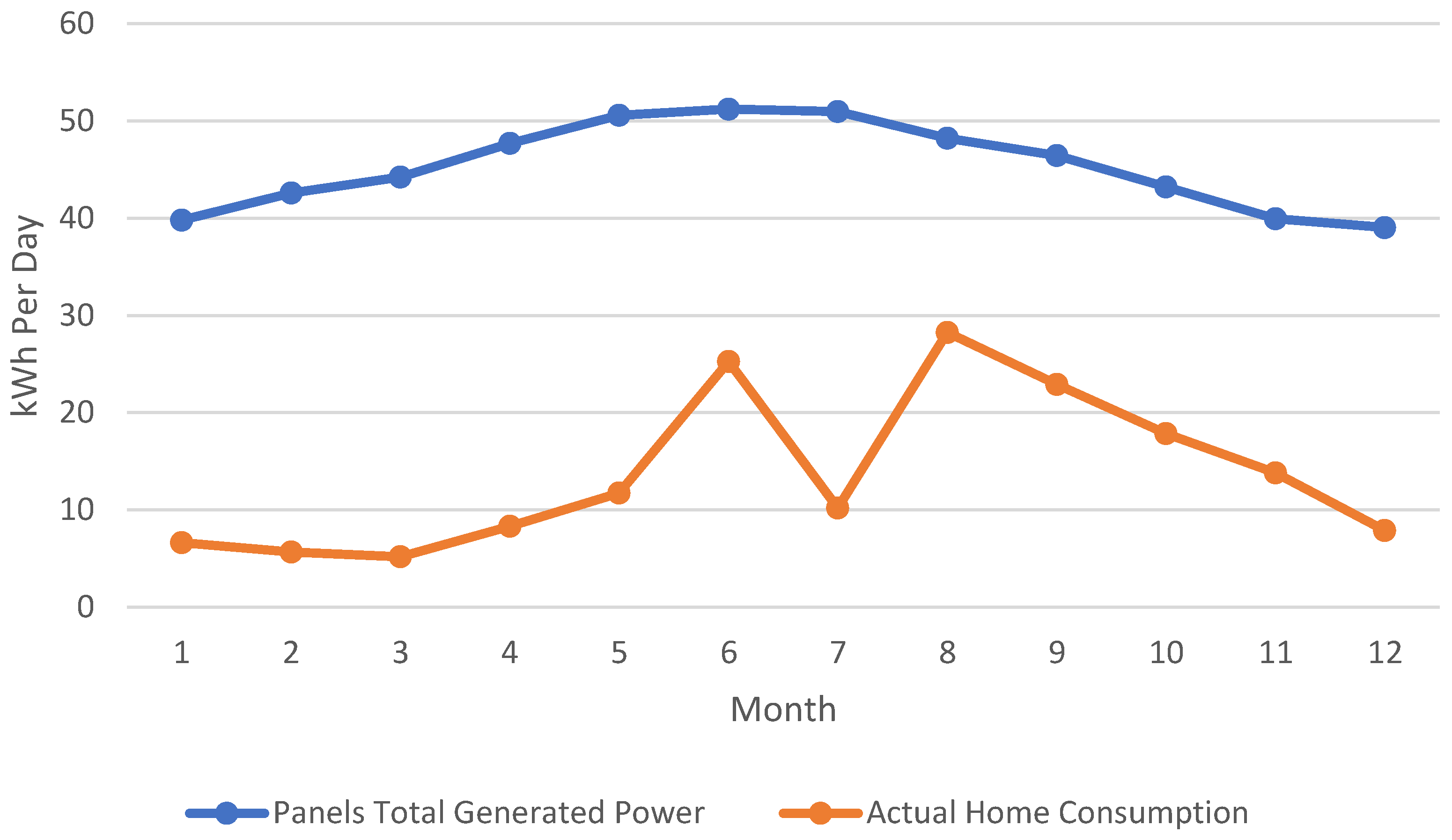
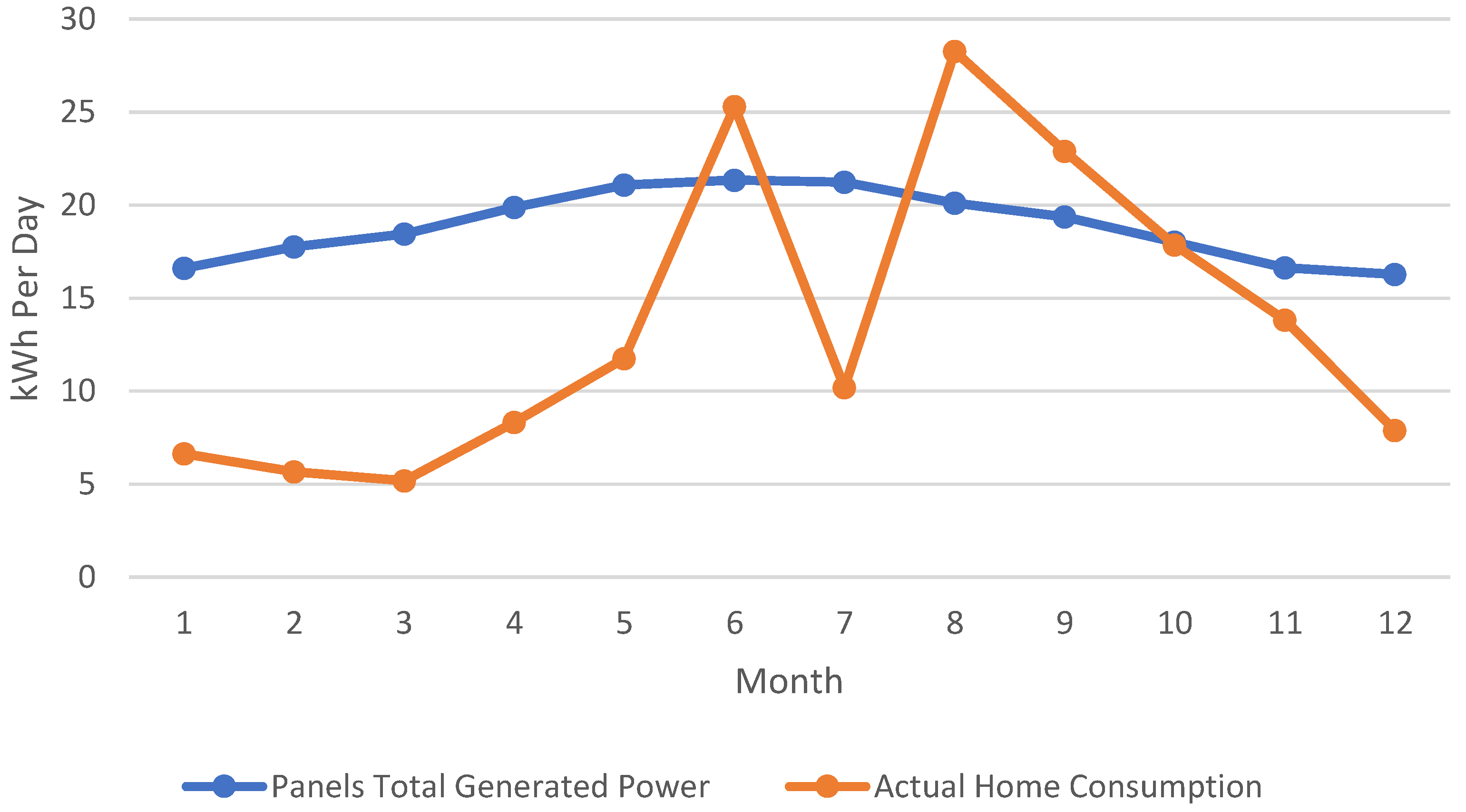
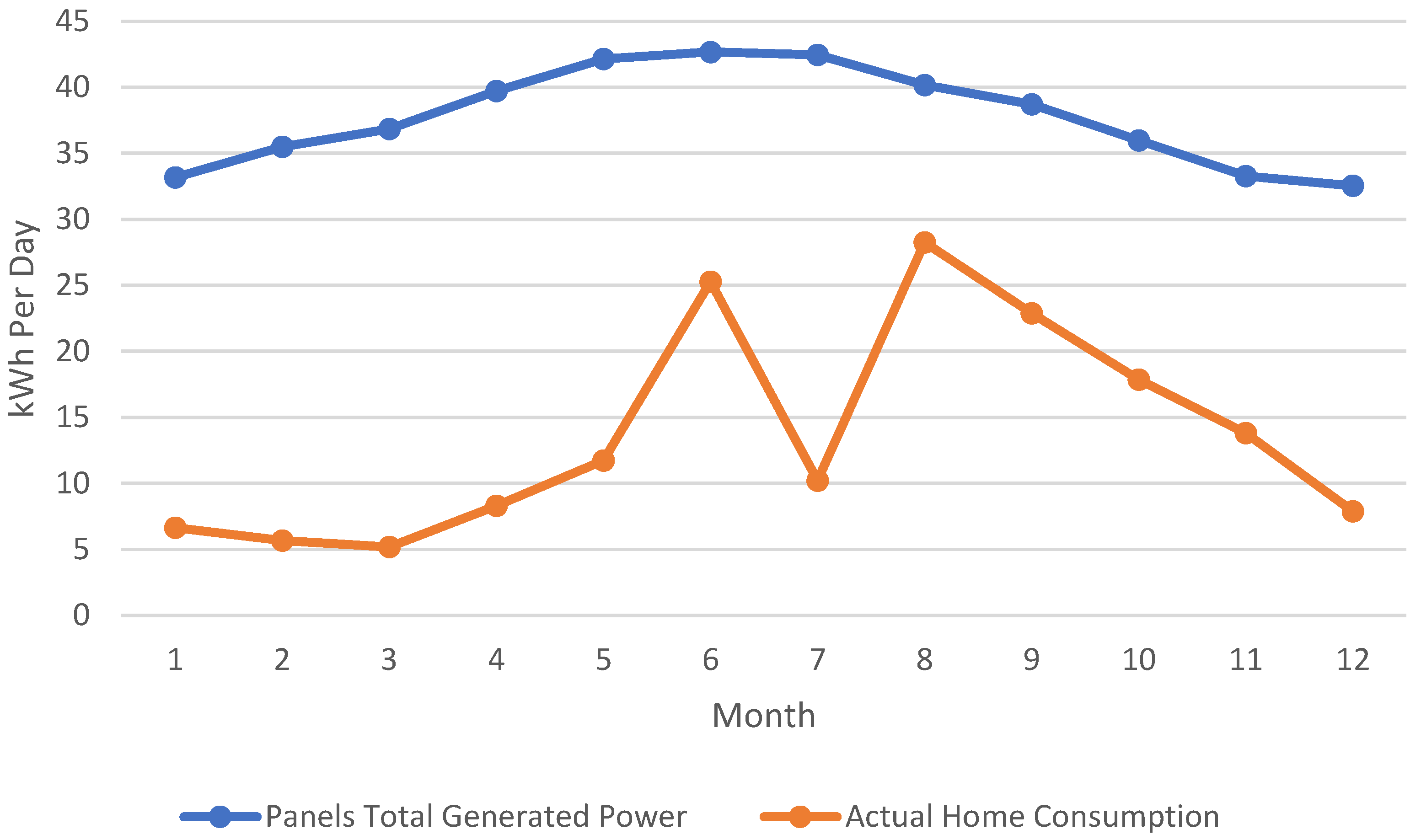

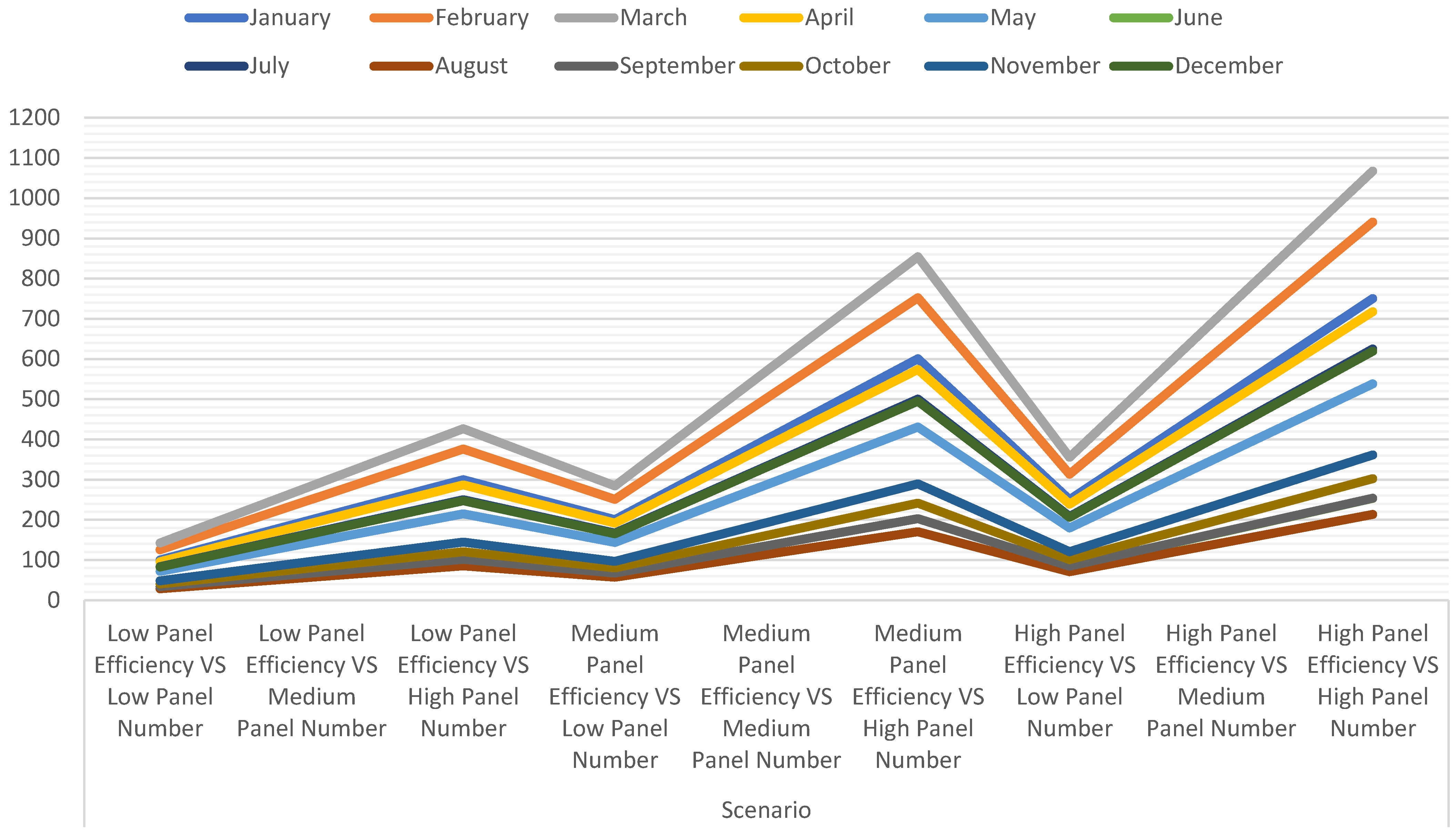
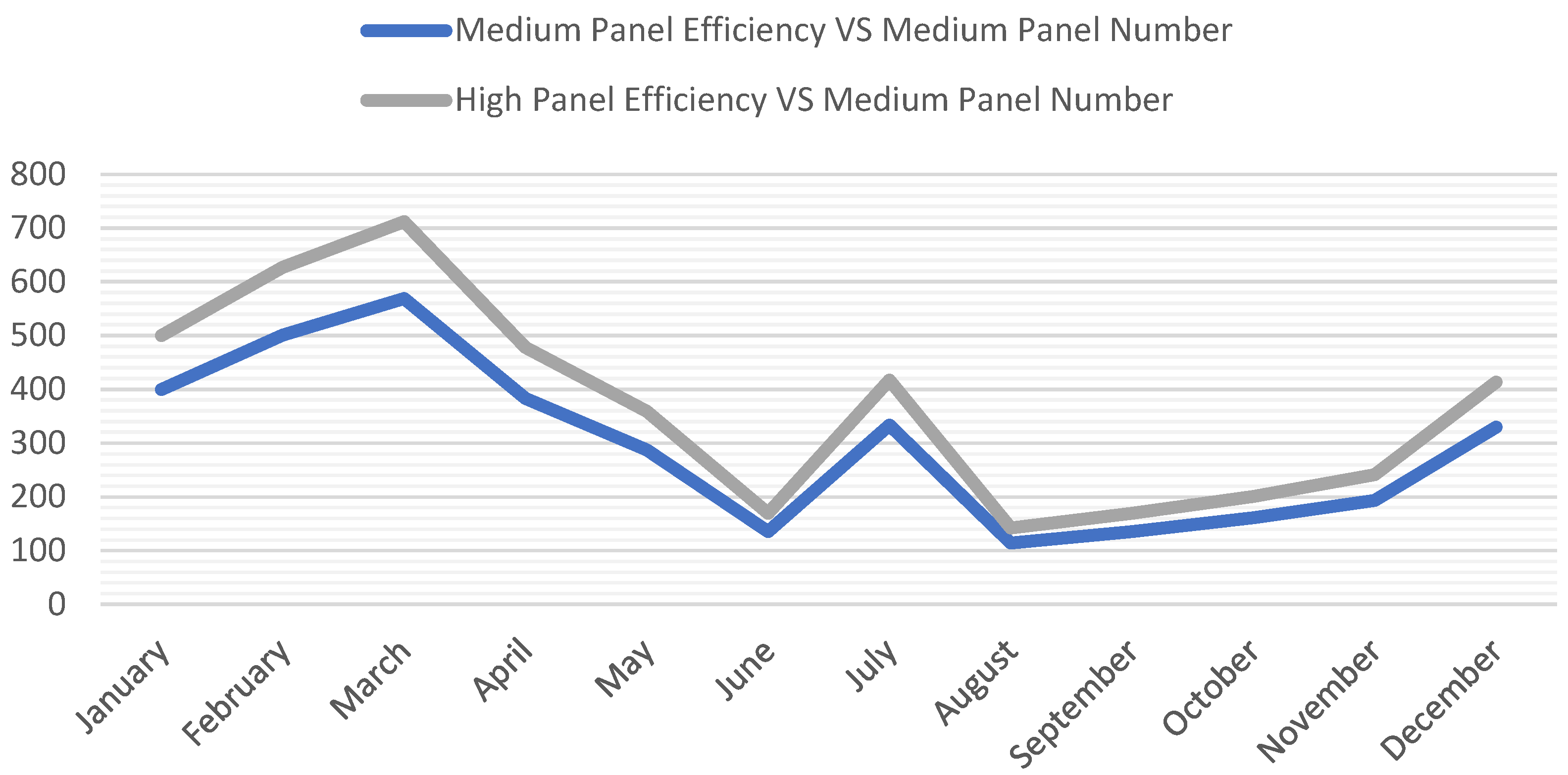

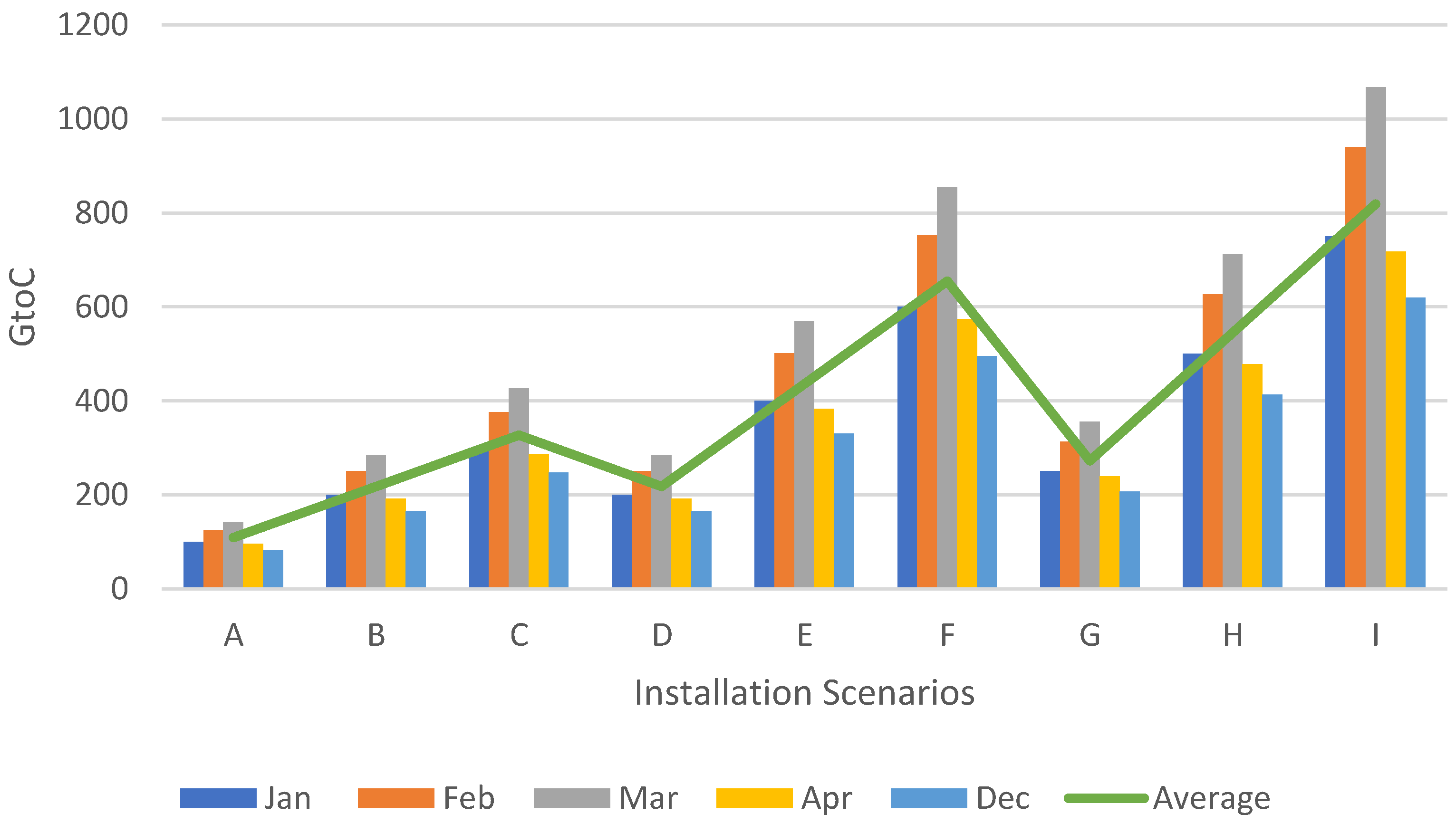
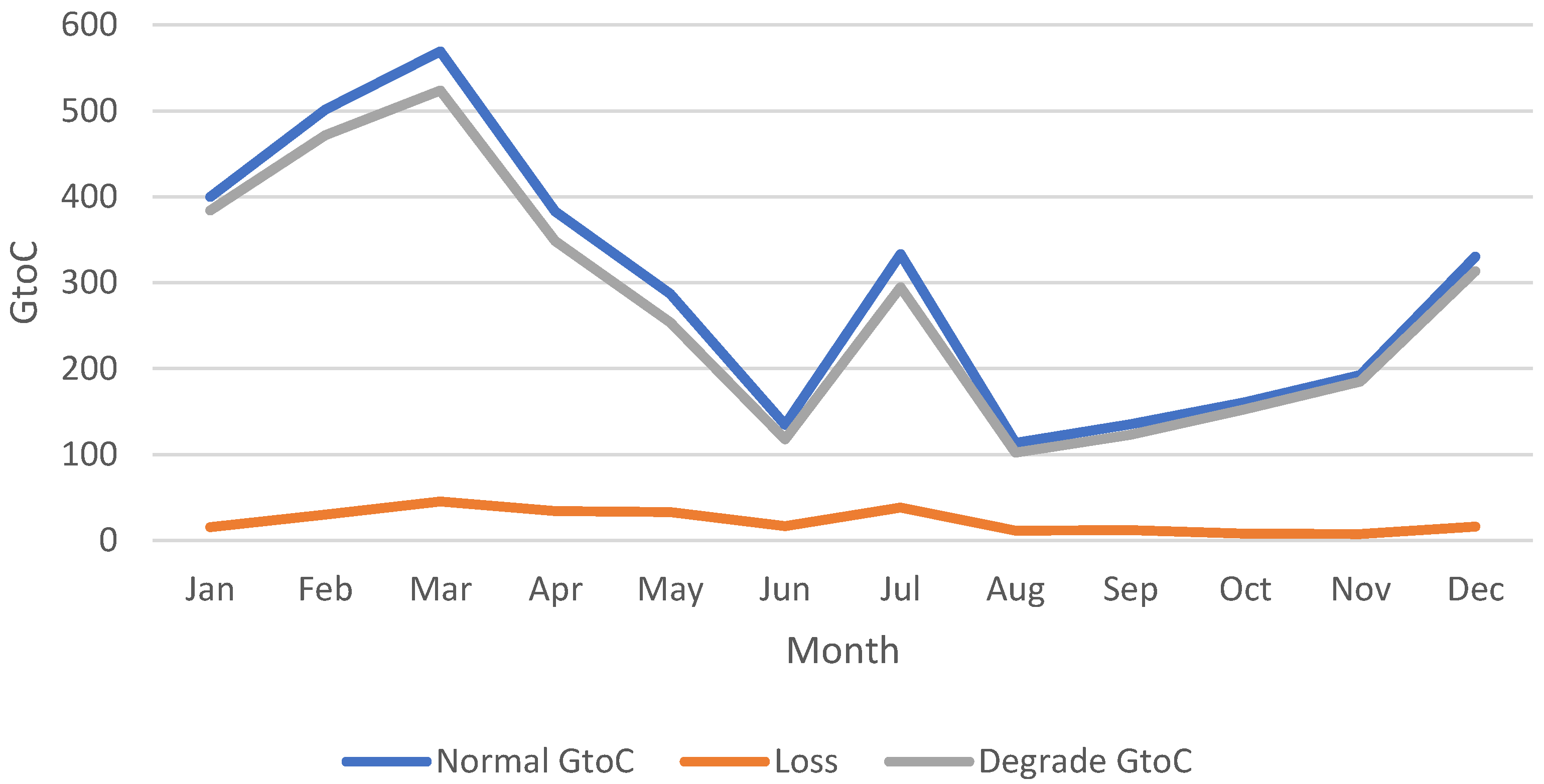
| Item | Measurement | Remarks |
|---|---|---|
| Total area | 900 | m2 |
| Penthouse roof area | 56.72 | m2 |
| Total roof area | 65.47 | m2 |
| No. bedrooms | 10 | Excluding lounges |
| No. inhabitants | 15 | Including 3 children |
| No. air-conditioning unit | 19 | 114 kW |
| Scenario | Panel Efficiency (%) | No. Panels | Panel Area (m2) |
|---|---|---|---|
| LPE vs. LPN | 20 | 2 | 3.2 |
| LPE vs. MPN | 4 | 6.4 | |
| LPE vs. HPN | 6 | 9.6 | |
| MPE vs. LPN | 40 | 2 | 3.2 |
| MPE vs. MPN | 4 | 6.4 | |
| MPE vs. HPN | 6 | 9.6 | |
| HPE vs. LPN | 50 | 2 | 3.2 |
| HPE vs. MPN | 4 | 6.4 | |
| HPE vs. HPN | 6 | 9.6 |
| Scenario | |||||||||
|---|---|---|---|---|---|---|---|---|---|
| A | B | C | D | E | F | G | H | I | |
| January | 100.0271 | 200.0543 | 300.0814 | 200.0543 | 400.1085 | 600.1628 | 250.0678 | 500.1356 | 750.2035 |
| February | 125.3993 | 250.7986 | 376.1979 | 250.7986 | 501.5972 | 752.3958 | 313.4982 | 626.9965 | 940.4947 |
| March | 142.3046 | 284.6091 | 426.9137 | 284.6091 | 569.2183 | 853.8274 | 355.7614 | 711.5229 | 1067.284 |
| April | 95.67646 | 191.3529 | 287.0294 | 191.3529 | 382.7058 | 574.0587 | 239.1911 | 478.3823 | 717.5734 |
| May | 71.74668 | 143.4934 | 215.24 | 143.4934 | 286.9867 | 430.4801 | 179.3667 | 358.7334 | 538.1001 |
| June | 33.76681 | 67.53362 | 101.3004 | 67.53362 | 135.0672 | 202.6009 | 84.41702 | 168.834 | 253.2511 |
| July | 83.31175 | 166.6235 | 249.9353 | 166.6235 | 333.247 | 499.8705 | 208.2794 | 416.5588 | 624.8381 |
| August | 28.44344 | 56.88688 | 85.33031 | 56.88688 | 113.7738 | 170.6606 | 71.10859 | 142.2172 | 213.3258 |
| September | 33.82693 | 67.65387 | 101.4808 | 67.65387 | 135.3077 | 202.9616 | 84.56733 | 169.1347 | 253.702 |
| October | 40.2955 | 80.591 | 120.8865 | 80.591 | 161.182 | 241.773 | 100.7388 | 201.4775 | 302.2163 |
| November | 48.16905 | 96.33811 | 144.5072 | 96.33811 | 192.6762 | 289.0143 | 120.4226 | 240.8453 | 361.2679 |
| December | 82.55708 | 165.1142 | 247.6712 | 165.1142 | 330.2283 | 495.3425 | 206.3927 | 412.7854 | 619.1781 |
| Traffic Light | Representation | Mathematical Illustration |
|---|---|---|
| Red | Generated energy < consumed energy | |
| Amber | Generated energy ≥ consumed energy | |
| Green | Generated energy > consumed energy |
Publisher’s Note: MDPI stays neutral with regard to jurisdictional claims in published maps and institutional affiliations. |
© 2022 by the authors. Licensee MDPI, Basel, Switzerland. This article is an open access article distributed under the terms and conditions of the Creative Commons Attribution (CC BY) license (https://creativecommons.org/licenses/by/4.0/).
Share and Cite
Banibaqash, A.; Hunaiti, Z.; Abbod, M. An Analytical Feasibility Study for Solar Panel Installation in Qatar Based on Generated to Consumed Electrical Energy Indicator. Energies 2022, 15, 9270. https://doi.org/10.3390/en15249270
Banibaqash A, Hunaiti Z, Abbod M. An Analytical Feasibility Study for Solar Panel Installation in Qatar Based on Generated to Consumed Electrical Energy Indicator. Energies. 2022; 15(24):9270. https://doi.org/10.3390/en15249270
Chicago/Turabian StyleBanibaqash, Ayed, Ziad Hunaiti, and Maysam Abbod. 2022. "An Analytical Feasibility Study for Solar Panel Installation in Qatar Based on Generated to Consumed Electrical Energy Indicator" Energies 15, no. 24: 9270. https://doi.org/10.3390/en15249270
APA StyleBanibaqash, A., Hunaiti, Z., & Abbod, M. (2022). An Analytical Feasibility Study for Solar Panel Installation in Qatar Based on Generated to Consumed Electrical Energy Indicator. Energies, 15(24), 9270. https://doi.org/10.3390/en15249270








